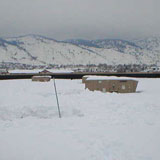System Roofing, a union company that installs single-ply roof systems, has a written safety program with specific safety rules. Each spring, the owner, Steve, and his three foremen have a safety-awareness meeting for the work force. Periodically, Steve also provides safety-awareness information in employees' paycheck envelopes.
New employees, who are acquired from the local union, must complete the union-sponsored apprenticeship program and work with a foreman in a mentoring program for six months. Steve thought these practices created a safety-awareness culture at System Roofing.
One winter, Mark was the foreman on an industrial job with a three-person crew. The crew noted the surface of the roof was frosted and slippery. Mark informed his crew to stay off the roof until he returned from the shop with a torch to melt the frost.
When Mark left, two crew members went on the roof against Mark's instructions; they slid off the 14-foot- (4-m-) high roof. The other crew member called 911, and by the time Mark returned, two ambulances had arrived. Mark was surprised the workers had disobeyed his instructions because they had been adequately trained and knew about the roof's condition.
The workers were seriously injured—one fractured his skull and broke his pelvis, and the other broke his wrist in several places and had to have immediate surgery.
Shortly after the insurance claim was reported, System Roofing's insurance company's loss-control specialist, Chris, came to the office to discuss the situation. Steve told Chris he felt betrayed by his employees and hurt because they had disobeyed Mark. Chris said there does not seem to be respect for supervision and safety procedures at System Roofing.
Chris explained that to have employees comply with published safety rules, it is necessary to have a disciplinary policy. Only when management establishes a clear expectation of behavior and has the means to enforce that behavior will safety procedures positively be affected. Chris also said employees should have certain responsibilities regarding their health and safety that, if not adequately exercised, will result in some type of disciplinary action.
The Occupational Safety and Health Administration views disciplinary procedures as an indispensable piece of a company's approach to protecting employees' safety and health. When safe work practices, clearly understood and fairly enforced disciplinary procedures, and management accountability go hand-in-hand, workers probably won't take short cuts.
Chris gave Steve the following tips to set up a disciplinary policy. Chris said all employees should know a violation of System Roofing's safety rules will result in a written warning. The written warning clearly and unambiguously should explain to the employee the deficiency in his performance and why his performance was unacceptable. Also, previous oral counseling given to the employee to warn him about his performance should be noted.
The employee then should be informed of the company's expectations for his future behavior and the results if such expectations are not met. Chris suggested adding the following into the policy: "Understand that complying with safety requirements is mandatory and required by law and serves to protect both you and the company. Consequently, further violations of our safety requirements, depending on the circumstances, will result in appropriate discipline up to and including discharge."
A written warning also should be delivered as part of an oral counseling session. The positive aspects of the employee's performance should be stressed while also stressing the need to address the deficiency that is the subject of the written warning. In the case of the injured workers, the positive aspect may be that they were eager to start work and thought Mark would be gone too long.
In all cases, the employee should explain why he didn't perform as expected. The employee should be given the opportunity to ask questions or offer explanations. This increases the likelihood of employee cooperation. Even when an employee is in the wrong, a reasonable opportunity for discussion should be provided.
Once the employee has been counseled, the original warning should be placed in the employee's personnel folder and a copy should be given to the employee.
The terrible accident involving Steve's employees certainly made him understand the importance of establishing disciplinary procedures. He decided to do what was necessary to help immediately instill a better, more thorough safety culture at his company. He knew his loss ratio temporarily would increase this year, but he wanted to prevent future increases and help his employees stay safe.
Leslie Kazmierowski is NRCA's insurance programs manager.

